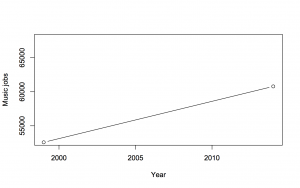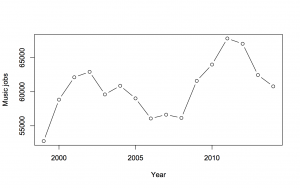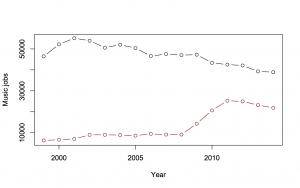Changing who you count
The New York Times has a well-deserved reputation for data journalism, but anyone can have a bad day. There’s a piece by Steven Johnson on the non-extinction of the music industry (which I think makes some good points), but which the Future of Music Coalition doesn’t like at all. And they also have some good points.
In particular, Johnson says
“According to the OES, in 1999 there were nearly 53,000 Americans who considered their primary occupation to be that of a musician, a music director or a composer; in 2014 more than 60,000 people were employed writing, singing, or playing music. That’s a rise of 15 percent.”
He’s right. This is a graph (not that you really need one)
The Future of Music Coalition give the numbers for each year, and they’re interesting. Here’s a graph of the totals:
There isn’t a simple increase; there’s a weird two-humped pattern. Why?
Well, if you look at the two categories, “Music Directors and Composers” and “Musicians and Singers”, making up the total, it’s quite revealing
The larger category, “Musicians and Singers”, has been declining. The smaller category, “Music Directors and Composers” was going up slowly, then had a dramatic three-year, straight-line increase, then decreased a bit.
Going into the Technical Notes for the estimates (eg, 2009), we see
May 2009 estimates are based on responses from six semiannual panels collected over a 3-year period
That means the three-year increase of 5000 jobs/year is probably a one-off increase of 15,000 jobs. Either the number of “Music Directors and Composers” more than doubled in 2009, or more likely there was a change in definitions or sampling approach. The Future of Music Coalition point out that Bureau of Labor Statistics FAQs say this is a problem (though they’ve got the wrong link: it’s here, question F.1)
Challenges in using OES data as a time series include changes in the occupational, industrial, and geographical classification systems
In particular, the 2008 statistics estimate only 390 of these people as being employed in primary and secondary schools; the 2009 estimate is 6000, and the 2011 estimate is 16880. A lot of primary and secondary school teachers got reclassified into this group; it wasn’t a real increase.
When the school teachers are kept out of “Music Directors and Composers”, to get better comparability across years, the change is from 53000 in 1999 to 47000 in 2014. That’s not a 15% increase; it’s an 11% decrease.
Official statistics agencies try not to change their definitions, precisely because of this problem, but they do have to keep up with a changing world. In the other direction, I wrote about a failure to change definitions that led the US Census Bureau to report four times as many pre-schoolers were cared for by fathers vs mothers.
Thomas Lumley (@tslumley) is Professor of Biostatistics at the University of Auckland. His research interests include semiparametric models, survey sampling, statistical computing, foundations of statistics, and whatever methodological problems his medical collaborators come up with. He also blogs at Biased and Inefficient See all posts by Thomas Lumley »



Many thanks for drilling down on the question of shifting categorization (and for noticing that broken link).
10 years ago
Anyone can have a bad day. Indeed. As you may not have realized, the OES numbers you cite here do not count self-employed musician (“Estimates do not include self-employed workers.”). So any argument based on OES numbers about the number of working musicians and composers – especially during a paradigm shift, as self-employed artists bypass record deals to make money from live performance and self-distribution online – would be tenuous at best. In fact, because Steven Johnson’s NY Times piece (on the non-extinction of the music industry) emphasized just that – how the end of record deals and the growth of live performance were changing the revenue models for musicians – his (and your reliance) on OES seems profoundly misguided. Please know, I genuinely appreciate and respect the even-handed approach of your post. But you should be aware that Robert Levine and others, are now using your post to make some (very specious) points. No doubt: It is hard “to keep up with a changing world.” But, as you point out, changing definitions should not be manipulated to mislead. I’d like to ask Mr. Levine: Would a decline in the number of employed stagecoach drivers suggest there were fewer drivers in the economy now that self-driven motorcars and self-employed truckers have joined the transport sector?
10 years ago
>>> I’d like to ask Mr. Levine: Would a decline in the number of employed stagecoach drivers suggest there were fewer drivers in the economy now that self-driven motorcars and self-employed truckers have joined the transport sector?
Of course not! But I don’t accept the parallel between the creative business and transport. The car was a more efficient way of getting people around. Similarly, the Internet is a more efficient way of delivering music. That’s why I celebrate business models like online track sales and music streaming. (I don’t always celebrate everything the companies involved in those businesses do, but that’s another story.) But while the Internet is clearly a more efficient way of delivering music, it may not be a more efficient way of making it. That’s still done by musicians. I hope you would agree that the digital age should replace distribution models but not musicians themselves.
The first of these things is clearly happening – we’re discussing whether the second is as well. Most statistics that measure the health of the music business point downward, but not all, and they obviously don’t measure the number of working musicians. But I’m not sure any of Johnson’s statistics measure this in a useful way either. Just to be clear: I NEVER suggested that these statistics proved anything. Steven Johnson did. He suggested that they showed more employment of musicians. I pointed out that, if this post is correct – and I assume it is but I haven’t done the research to check – it shows no such thing. All it shows is that the way the stats were tabulated changed. Isn’t this a point worth making?
I also think that the stats on self-employed musicians don’t prove much either, simply because the definition is so vague – what else is that musician doing, how much is he or she making from music, and how much of that is original creativity as opposed to teaching or something like it? I don’t think these statistics are useful, which is why I didn’t use them in my book.
I wrote a book that suggests creators will fare poorly in the absence of a market for creative works. I still believe that. There are plenty of statistics that suggest I’m right. There are others that suggest that’s not the case – and I think it’s weird that Johnson ignored many of them to focus on these Labor stats that simply don’t show much.
So why do I believe what I believe? Well, creators have rights over their work – both economic and otherwise. They should be able to make their own choices. I believe that markets that involve people making their own choices generally lead to better outcomes than other economic systems – I’m a left-leaning, skeptical capitalist but I think nothing else seems to work as well. And I believe that some form of copyright – not the one we have, but some form – is the best way we know of to establish a market for creative works.
A few last points: I think all of this should be up to creators. If they want to give away their works, they should be free to do so – and nothing under copyright law prohibits that (at least in the U.S.). I’m by no means against technology – I’m against some uses of some technology in some cases, but that’s a different issue entirely. Finally, while I don’t think I’m wrong, I certainly hope I am! I am a professional working journalist with few other skills, so the future of the creative businesses closely correlates to the future of my ability to put food on the table. If Johnson is right, and that future is brighter than I think, no one will be happier than I am.
10 years ago
Mr. Lumley….please clarify something for me: are you saying that these statistics count music teachers working in schools as working in the “music business?” Did I misread your post? I am hoping so, because while I have the greatest respect for ALL teachers, making a living as a music teacher, and making one in the music industry are profoundly different professions. Please tell me I misunderstood. Thanks.
10 years ago
The statistics are for the BLS classifications “Musicians and Singers” and “Music Directors and Composers”. Beginning in about 2009 they included at least some music teachers in “Music Directors and Composers”: about 15000 across the US. About half the rest of the “Music Directors and Composers” work for religious organisations.
For the “Musicians and Singers”, a bit more than half of them work in “Performing arts companies”, so that group is closer to what you probably think of as the music business.
The current definitions are “Conduct, direct, plan, and lead instrumental or vocal performances by musical groups, such as orchestras, bands, choirs, and glee clubs. Includes arrangers, composers, choral directors, and orchestrators. for “Music Directors and Composers” and “Play one or more musical instruments or sing. May perform on stage, for on-air broadcasting, or for sound or video recording. “ for “Musicians and Singers”
10 years ago
Wow. Thanks for the reply. I’ve been a professional composer for film and television for 25 years. My wife is a professional songwriter. As I said, without intending any disrespect for the teaching profession, it is absolutely ludicrous for the BLS to include music teachers in how they assess the number of jobs in the music profession. They should be classified as teachers, and to be highly valued. But if one is trying to assess trends in employment, the health of an industry, and certainly trying to make arguments such as the one made in the New York Times article, they should not be included. Thanks for pointing out the carelessness of the statistical analysis used by the author of that article.
10 years ago
Thomas,
Sorry for taking up so much space on your blog up there. What I should have said first is that I’m glad you looked into this and shared it with us.
-rob
10 years ago